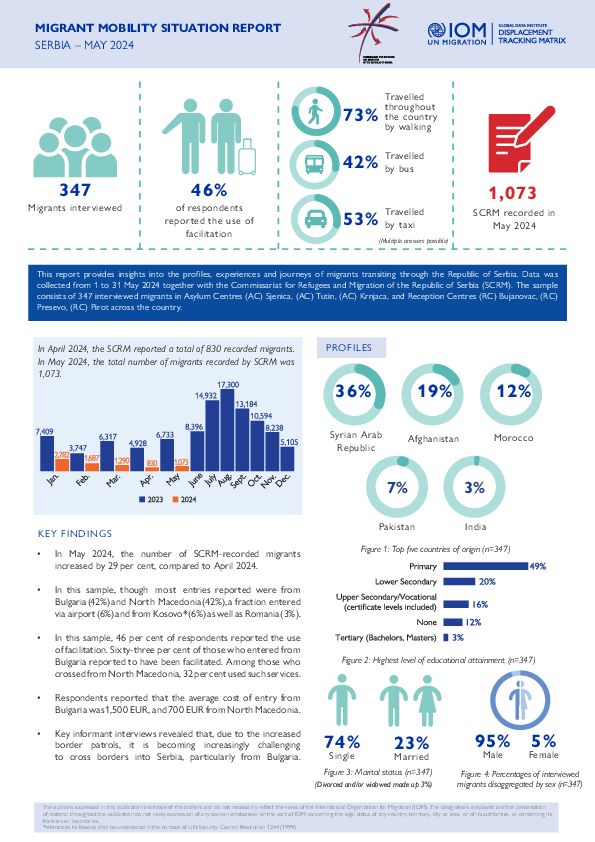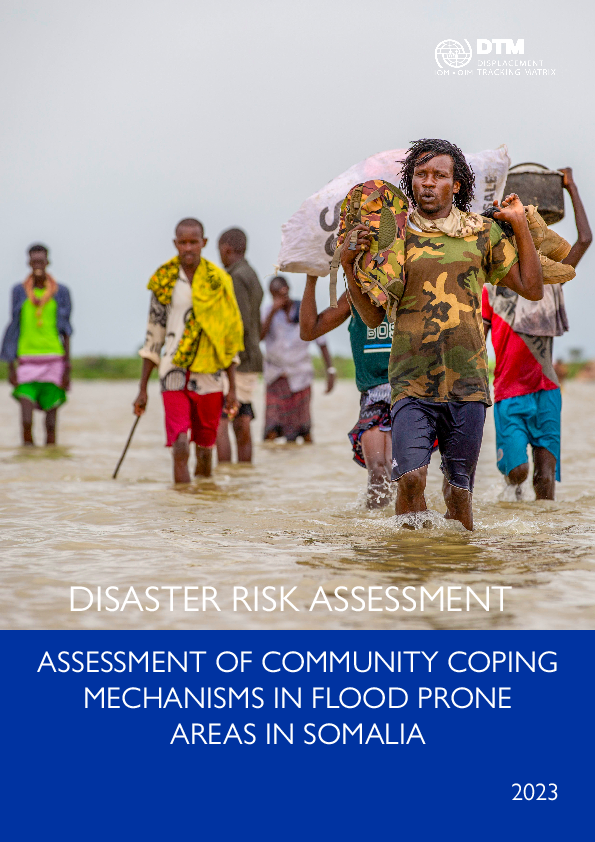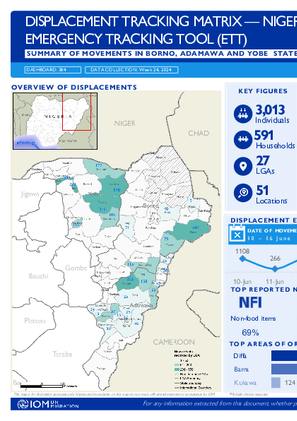-
Countries
-
Data and Analysis
-
Special Focus
-
Crisis Responses
Error message
The submitted value field_published_date_value in the Sort by element is not allowed.

Contact
DTM Sudan; dtmsudan@iom.int
Language
English
Location
Sudan
Snapshot Date
Jun 16 2024
Activity
- Mobility Tracking
- Baseline Assessment
This report reflects data corresponding to Sudan Mobility Update (3) dataset. The dataset is available here.
Overview:
This report provides an overview of the total population of internally displaced persons (IDPs) in Sudan, including those displaced both before and after the onset of conflict on 15 April 2023.
Key Findings:
- An estimated total of 10,540,215 IDPs were displaced across 8,556 locations, in 183 localities in all 18 states in Sudan.
- An estimated 7,720,119 individuals were displaced internally within Sudan since 15 April 2023.
- An estimated 26 per cent of IDPs who were initially displaced prior to the onset of current conflict experienced secondary displacement since 15 April 2023.
- Approximately 2,196,355 individuals crossed borders into neighbouring countries since 15 April 2023.
- The top states of origin among IDPs were Khartoum (36%), South Darfur (20%), and North Darfur (14%).
- The states hosting the most IDPs were South Darfur (17%), North Darfur (14%) and Central Darfur (8%).
- Over half (55%) of IDPs were reportedly children under the age of 18-years-old.
Note: The number of IDPs displaced post 15 April 2023 (7,720,119 IDPs) includes the estimated 1,000,676 IDPs who were initially displaced prior to 15 April 2023 and experienced secondary displacement since 15 April 2023. DTM Sudan defines an internally displaced person as any person who has been forced or obliged to flee from their habitual residence due to an event dating from 2003 onwards.
Jun 25 2024
Print
Global
No
Jun 25 2024
Print
DG ECHO
Global
No
Jun 25 2024
Print
MPTF
Global
No
Jun 25 2024
Print
European Commission
Global
No

Contact
DTM Europe, DTMMediterranean@iom.int
Language
English
Location
Serbia
Period Covered
May 01 2024
May 31 2024
Activity
- Survey
- Flow Monitoring
This report provides insights into the profiles, experiences and journeys of migrants transiting through the Republic of Serbia. Data was collected from 1 to 31 May 2024 together with the Commissariat for Refugees and Migration of the Republic of Serbia (SCRM). The sample consists of 347 interviewed migrants in Asylum Centres (AC) Sjenica, (AC) Tutin, (AC) Krnjaca, and Reception Centres (RC) Bujanovac, (RC) Presevo, (RC) Pirot across the country.

Contact
DTM Somalia, IOMSomaliaPSU@iom.int
Language
English
Location
Somalia
Period Covered
Oct 01 2023
Dec 31 2023
Activity
- Other
The assessment of community coping mechanisms conducted during the El Niño period of 2023 sought to evaluate the strategies employed by communities impacted by flooding along River Juba and Shabelle. The study specifically aimed to evaluate the coping strategies utilized by communities in the flood-prone districts of Baardheere, Balcad, Beledweyne, Bulo Burto, Doolow, and Jowhar districts during previous flood events and the El Niño of 2023. The analysis examined how these communities leveraged various economic, physical, structural, social, and institutional factors to cope with and adapt to the impacts of recurrent natural disasters like floods as part of a broader effort to enhance the understanding of disaster mitigation measures within Somalia’s Disaster Preparedness and Disaster Risk Reduction (DRR) framework. The findings underscored the urgent need for targeted interventions to bolster disaster resilience and strengthen community coping strategies amidst the challenges posed by the recurring flood cycles in Somalia.

Contact
DTM Somalia, IOMSomaliaPSU@iom.int
Language
English
Location
Somalia
Period Covered
Oct 01 2023
Dec 31 2023
Activity
- Other
The primary objective of this assessment was to evaluate the existence and effectiveness of early warning systems for enhanced disaster risk monitoring and reduction across 6 flood-prone districts in Somalia; Balcad, Baardheere, Beledweyne, Bulo Burto, Doolow and Jowhar. The assessment examined the status of the early warning systems, focusing on key components such as risk knowledge, monitoring and early warning, dissemination and communication, and response capabilities during the El Niño 2023 floods. By providing valuable insights into the current state of early warning capabilities within the evaluated districts, the assessment highlighted the critical gaps and areas requiring strengthening. This is crucial to ensure that communities are better prepared and able to respond effectively to the escalating climate-driven hazards, such as floods which have been exacerbated by the ongoing climate crisis in Somalia.

Contact
DTM Türkiye, mpmturkey@iom.int
Language
English
Location
Republic of Türkiye
Period Covered
Apr 01 2024
Jun 30 2024
Activity
- Flow Monitoring
According to the latest figures from the Turkish Presidency of Migration Management (PMM), there are more than 4.5 million foreigners in Türkiye, of whom 3.4 million are seeking international protection. Most of them are Syrians (3,115,844) who have been granted temporary protection status. Another group of foreigners are international protection holders mainly from Iraq, Afghanistan, the Islamic Republic of Iran and Ukraine.
In 2023, according to the United Nations High Commissioner for Refugees (UNHCR), there were 296,685 refugees and asylum seekers in Türkiye. In addition, 1,119,919 foreigners with residence permits were in Türkiye as of April 2024, which is 187,928 people less than in April 2023.

Contact
iomnigeriadtm@iom.int
Language
English
Location
Nigeria
Period Covered
Jun 10 2024
Jun 16 2024
Activity
- Registration
- Mobility Tracking
- Event Tracking
Between 10 and 16 June 2024, a total of 3,013 new arrivals were recorded at locations in Adamawa, Borno, and Yobe states. The new arrivals were recorded at locations in Askira/Uba, Bama, Gwoza, Kaga, Mafa, and Ngala Local Government Areas (LGAs) of the most conflict-affected Borno State, in Demsa, Fufore, Girei, Gombi, Hong, Lamurde, Madagali, Maiha, Mayo Belwa, Michika, Mubi South, Numan, Song, Yola North and Yola South LGAs of Adamawa State and in Bade, Damaturu, Geidam, Potiskum, Tarmua and Yunusari LGAs of Yobe State.
ETT assessments identified the following movement triggers: fear of attack (1,176 individuals or 39%), military operations (576 individuals or 19%), poor living conditions (507 individuals or 17%), improved security (390 individuals or 13%), family re-unification (194 individuals or 6%) and seasonal farming (170 individuals or 6%).
